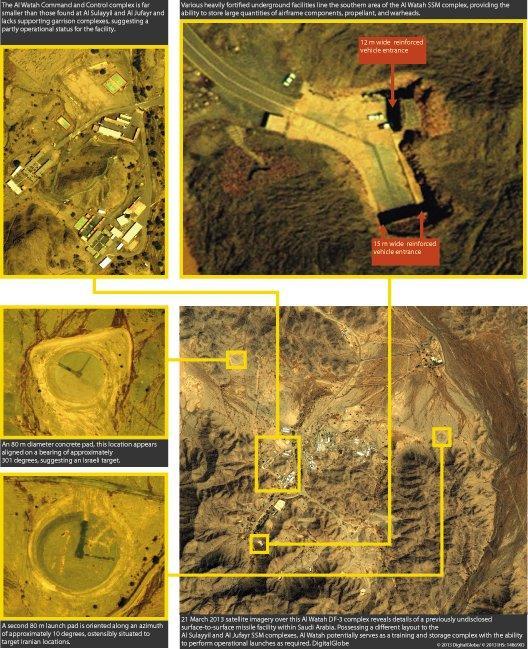Satellite images suggest that Saudi Arabia has constructed its first known ballistic missile factory, according to weapons experts and image analysts, a development that raises questions about the kingdom’s increasing military and nuclear ambitions under its 33-year-old crown prince. If operational, the suspected factory at a missile base in al-Watah, southwest of Riyadh, would allow Saudi Arabia to manufacture its own ballistic missiles, fueling fears of an arms race against its regional rival Iran. Saudi Arabia currently does not possess nuclear weapons, so any missiles produced at the apparent factory are likely to be conventionally armed. But a missile-making facility would be a critical component of any eventual Saudi nuclear weapons program, hypothetically giving the kingdom capability to produce the preferred delivery systems for nuclear warheads.
Two additional missile experts who reviewed the satellite images for The Washington Post… agreed that the high-resolution photographs of the al-Watah site appear to depict a rocket-engine production and test facility, probably using solid fuel…The complex…highlights the nation’s intention to make its own advanced missiles after years of seeking to purchase them abroad, at times successfully….
Saudi Arabia has been pursuing a nuclear power-plant deal with the United States that would potentially include allowing it to produce nuclear fuel. The kingdom’s insistence on domestic fuel production has raised worries among U.S. officials that the kingdom wants the atomic power project not only for civil use but also for covert weapon-making purposes. ..
How the Saudis obtained the technological expertise necessary to build the facility is unclear. One potential supplier: China…China has sold ballistic missiles to Saudi Arabia in the past and has helped supply ballistic missile production capabilities to other nations. In the 1990s, Pakistan secretly built a plant for medium-range missiles using blueprints and equipment supplied by China. The factory in Pakistan has long drawn the attention of top Saudi officials. ..
The main way the United States seeks to prevent the spread of drone and missile technology is through the Missile Technology Control Regime, or the MTCR, an informal multicountry pact designed to prevent the transfer of certain missile technologies. China is not a member but has agreed to abide by some of its stipulations. While the United States sells an array of weaponry to Saudi Arabia, Washington has not sold ballistic missiles to Riyadh, in part because such missiles traditionally have been seen as destabilizing for the region. Saudi Arabia has turned to China in the past when met with refusals from the United States for certain weapons requests.
For example, the United States declined repeated Saudi requests to purchase what are known as category-one American drones, including Predators and Reapers, partly because of MTCR’s regulations. Instead, the kingdom turned to China, first purchasing drones and later striking a deal in which China will build a drone factory that will produce a Chinese copycat of the Predator in Saudi Arabia.
Excerpts Paul Sonne, Can Saudi Arabia produce ballistic missiles? Satellite imagery raises suspicions, Washington Post, Jan. 22, 2019
